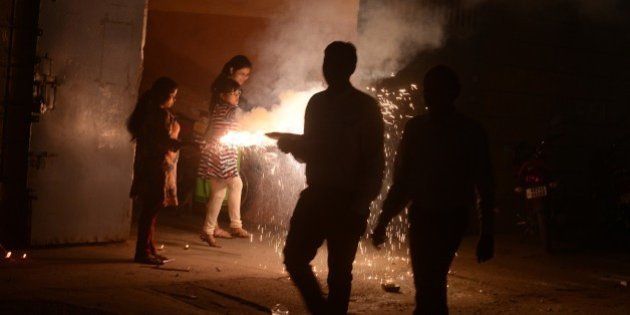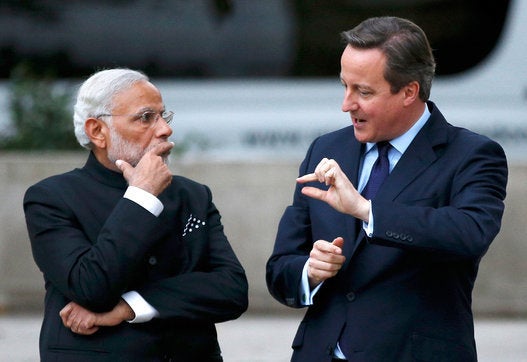
NEW DELHI -- Air quality in the national capital oscillated between "severe" and "very poor" levels with pollutants rising exponentially and noise pollution peaking owing to incessant fireworks and bursting of crackers on Diwali night.
The intensity of air pollution on Diwali night was "less" compared to last year, presumably due to wind movement, as per Centre for Science and Environment (CSE). The Delhi government attributed the reduction to its anti-firecracker campaign.
System of Air Quality and Weather Forecasting and Research (SAFAR), which observed air quality of the "Diwali period" of last three days, said the city was "more polluted" than last year. It said the overall levels of PM 2.5 and PM 10 were 258 and 386 micrograms per cubic metre last night.
It identified Palam, Delhi University, Pitampura and Noida as the leading pollution spots in the city with corresponding PM 2.5 readings at 344, 275, 281 and 302 respectively.
SAFAR, a Ministry of Earth Sciences entity, said air quality in number of areas was "severe" which means the level of PM 2.5 and PM 10 were above 253, 421 micro gram per cubic metre. "Severe" is used to describe the highest level of pollution.
The "very poor" category is declared when PM 10 and PM 2.5 levels are between 351 and 420 and 211 to 252 micro gram per cubic metre.
As per the Delhi government, whose analysis was based on 'Ambient Air Quality' (outdoor air quality over long-term) data of six stations, maximum average values of sulphur dioxide, nitrogen dioxide and PM 2.5 were lower at these locations on this Diwali compared to their corresponding values on the occasion of Diwali in 2014.
The Delhi Pollution Control Committee (DPCC) stations are located at R K Puram, Mandir Marg, Punjabi Bagh, Civil Lines, Anand Vihar and IGI airport.
Delhi government attributed the reduction to people's positive response to its anti-firecrackers campaign, involving Chief Minister Arvind Kejriwal among others. CSE said it was due to comparatively less crackers and mild wind in some parts.
"The recorded wind speed during 2015 Diwali was 1.19 metre per second in contrast to 0.62 m/s in 2014 the wind speed in this Diwali had almost doubled," a CSE statement said.
But the NGO claimed that its exposure monitoring, essentially the level of pollution within breathing zone at the time crackers were burst, threw up figures showing "alarming levels of exposure".
"People breathed several times higher pollution than the ambient level monitored by DPCC. Overall, during Diwali evenings people breathed an hourly average that is at least 3 to 4 times higher than the ambient monitoring recorded at the DPCC stations," the CSE said.
As per Delhi government, 24 hours average of PM 2.5, which are finer and more harmful to those susceptible to ailments of the respiratory tract, ranged from 184 g/m3 to 369 g/m3 on November 11.
The minimum was observed at Civil Lines and maximum at R K Puram. On Diwali Day in 2014, the average concentration (for 24 hrs) for PM2.5 ranged from 145 g/m3 to 500 g/m3, government said.
PM 10 average over the same period ranged from 296 g/m3 to 778 g/m3. The minimum was observed at the airport area and maximum at Anand Vihar. On Diwali Day in 2014, the average concentration (for 24 hrs) for PM10 ranged from 421 g/m3 to 790 g/m3.
As per Central Pollution Control Board (CPCB) data, in general, there was increase in ambient noise level due to bursting of crackers as compared to last year.
The noise level at Mayur Vihar Phase-II and Kamla Nagar reported 86 Leq dB(A). There was increase in noise level at night time at all locations except Delhi Technological University at Bawana, it said.
At Anand Vihar, level of PM 10 crossed the 2,000 microgram per cubic metre around midnight, which is 20 times more than the safe level of 100. R K Puram recorded the same as 1,333 at around 1 AM.
PM 2.5, finer and more harmful to those susceptible to ailments of the respiratory tract, was at 734 at R K Puram and 619 at Punjabi Bagh around the same time as opposed to the permissible limit of 60.
However, Project Director of SAFAR Guffrain Beig explained that these numbers should not be compared to the safe limits, which are based on a 24-hour average, to draw conclusion on pollution levels.
The air quality in Delhi has deteriorated significantly in past few weeks.
Kejriwal had appealed to people not to burst firecrackers during Diwali so that pollution level in the city does not deteriorate further.



Contact HuffPost India
Also On HuffPost:
